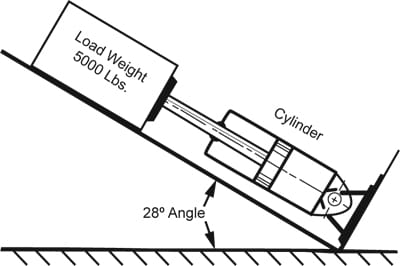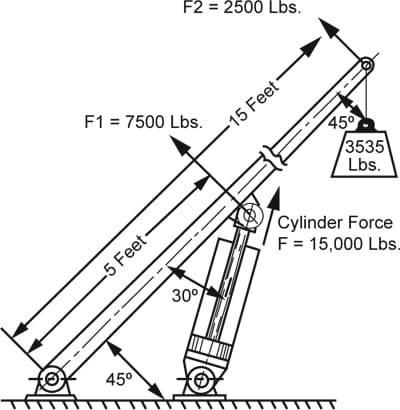Data Sheet 5: Angle Problems in Fluid Power Applications
Trigonometric functions such as sines, cosines, and tangents are useful in solving angle problems… for example if the cylinder axis is at an angle to the direction of load movement… in beam and crane problems where the cylinder is not at right angles with the beam axis, and where the angle continually changes as the beam rises… applications where a heavy load moves upward or downward at an inclination to the horizontal…
The purpose of this sheet is to show simplified methods of using multipliers and dividers in solving these problems. While these methods are based on trigonometry, a knowledge of the subject is not necessary to use these methods
How to Calculate a Friction Load… Figure 1 – Horizontal Friction… Frictional resistance depends on the coefficient of friction between the mating surfaces. Coefficients for various materials are shown in machinery handbooks. For example, steel running on cast iron, lubricated, has a coefficient of 0.2. In this figure, using this coefficient with a load weight of 4500 lbs., friction in a horizontal direction is 4500 x 0.2 = 900 lbs. Figure 1 – Horizontal Friction… Frictional resistance depends on the coefficient of friction between the mating surfaces. Coefficients for various materials are shown in machinery handbooks. For example, steel running on cast iron, lubricated, has a coefficient of 0.2. In this figure, using this coefficient with a load weight of 4500 lbs., friction in a horizontal direction is 4500 x 0.2 = 900 lbs. |  Figure 2 – Friction on Inclined Plane… If the load is sliding at an angle with the horizontal, use cosine of angle as a multiplier. Using a coefficient of friction 0. 2, friction of a 4500 lb. load on a 40° incline is 4500 x 0. 2 x 0.766 (cos 40°) = 689 lbs. Figure 2 – Friction on Inclined Plane… If the load is sliding at an angle with the horizontal, use cosine of angle as a multiplier. Using a coefficient of friction 0. 2, friction of a 4500 lb. load on a 40° incline is 4500 x 0. 2 x 0.766 (cos 40°) = 689 lbs. |
Cylinders Pushing at an Angle to Load Direction…
 Figure 3 – Additional cylinder force is required if cylinder is not pushing directly into load. Downward acting cylinder increases friction of the load. Figure 3 – Additional cylinder force is required if cylinder is not pushing directly into load. Downward acting cylinder increases friction of the load. | If the cylinder axis is not parallel to direction of load movement, more force is required than if it were pushing straight on. When it is pushing at a downward angle, its force will actually create additional friction. The problem is to calculate the cylinder force required. Space does not permit showing the mathematical solution, which involves tangents and sines of the angles involved. This can be found in an engineering book on mechanics. Our simplified solution is the table of multipliers, which are to be multiplied times the weight of the load according to the coefficient of friction and the angle which the cylinder makes with the load. This table has been mathematically calculated for the range of conditions shown and may be used directly. |
| MULTIPLIERS (See Text) | |||||||||
| Coef. of Friction | Angle of Cylinder Axis to the Horizontal | ||||||||
| 10º | 15º | 20º | 25º | 30º | 35º | 40º | 45º | 50º | |
| 0.10 | .103 | .107 | .111 | .116 | .123 | .132 | .143 | .158 | .178 |
| 0.20 | .210 | .219 | .230 | .243 | .261 | .284 | .314 | .353 | .408 |
| 0.30 | .321 | .337 | .358 | .384 | .418 | .463 | .523 | .605 | .724 |
| 0.40 | .436 | .463 | .498 | .542 | .600 | .677 | .784 | .942 | 1.19 |
| 0.50 | .557 | .598 | .650 | .719 | .811 | .939 | 1.12 | 1.41 | 1.93 |
| 0.60 | .682 | .741 | .817 | .920 | 1.06 | 1.27 | 1.58 | 2.13 | 3.28 |
| 0.70 | .810 | .891 | .998 | 1.14 | 1.35 | 1.68 | 2.21 | 3.29 | 6.59 |
| 0.80 | .951 | 1.12 | 1.21 | 1.42 | 1.74 | 2.26 | 3.26 | 5.95 | 34.7 |
| 0.90 | 1.09 | 1.23 | 1.43 | 1.71 | 2.17 | 2.97 | 4.81 | 12.9 | – – – |
Trig Table
3-Place sines and cosines for problems on this sheet. Refer to mathematical reference book for values not in this table.
| Angle | Sine | Cosine |
| 5 | 0.087 | 0.996 |
| 6 | 0.105 | 0.995 |
| 7 | 0.122 | 0.993 |
| 8 | 0.139 | 0.990 |
| 9 | 0.156 | 0.988 |
| 10 | 0.174 | 0.985 |
| 11 | 0.191 | 0.982 |
| 12 | 0.208 | 0.978 |
| 13 | 0.225 | 0.974 |
| 14 | 0.242 | 0.970 |
| 15 | 0.259 | 0.966 |
| 16 | 0.276 | 0.961 |
| 17 | 0.292 | 0.956 |
| 18 | 0.309 | 0.951 |
| 19 | 0.326 | 0.946 |
| 20 | 0.342 | 0.940 |
| 21 | 0.358 | 0.934 |
| 22 | 0.375 | 0.927 |
| 23 | 0.391 | 0.921 |
| 24 | 0.407 | 0.914 |
| 25 | 0.423 | 0.906 |
| 26 | 0.438 | 0.899 |
| 27 | 0.454 | 0.981 |
| 28 | 0.469 | 0.883 |
| 29 | 0.485 | 0.875 |
| 30 | 0.500 | 0.866 |
| 31 | 0.515 | 0.857 |
| 32 | 0.530 | 0.848 |
| 33 | 0.545 | 0.839 |
| 34 | 0.559 | 0.829 |
| 35 | 0.574 | 0.819 |
| 36 | 0.588 | 0.809 |
| 37 | 0.602 | 0.799 |
| 38 | 0.616 | 0.788 |
| 39 | 0.629 | 0.777 |
| 40 | 0.643 | 0.766 |
| 41 | 0.656 | 0.755 |
| 42 | 0.669 | 0.743 |
| 43 | 0.682 | 0.731 |
| 44 | 0.695 | 0.719 |
| 45 | 0.707 | 0.707 |
| 46 | 0.719 | 0.695 |
| 47 | 0.731 | 0.682 |
| 48 | 0.743 | 0.669 |
| 49 | 0.755 | 0.656 |
| 50 | 0.766 | 0.643 |
| 51 | 0.777 | 0.629 |
| 52 | 0.788 | 0.616 |
| 53 | 0.799 | 0.602 |
| 54 | 0.809 | 0.588 |
| 55 | 0.819 | 0.574 |
| 56 | 0.829 | 0.559 |
| 57 | 0.839 | 0.545 |
| 58 | 0.848 | 0.530 |
| 59 | 0.857 | 0.515 |
| 60 | 0.866 | 0.500 |
| 61 | 0.875 | 0.485 |
| 62 | 0.883 | 0.469 |
| 63 | 0.891 | 0.454 |
| 64 | 0.899 | 0.438 |
| 65 | 0.906 | 0.423 |
| 66 | 0.914 | 0.407 |
| 67 | 0.921 | 0.391 |
| 68 | 0.927 | 0.375 |
| 69 | 0.934 | 0.358 |
| 70 | 0.940 | 0.342 |
| 71 | 0.946 | 0.326 |
| 72 | 0.951 | 0.309 |
| 73 | 0.956 | 0.292 |
| 74 | 0.961 | 0.276 |
| 75 | 0.966 | 0.259 |
| 76 | 0.970 | 0.242 |
| 77 | 0.974 | 0.225 |
| 78 | 0.978 | 0.208 |
| 79 | 0.982 | 0.191 |
| 80 | 0.985 | 0.174 |
| 81 | 0.988 | 0.156 |
| 82 | 0.990 | 0.139 |
| 83 | 0.993 | 0.122 |
| 84 | 0.995 | 0.105 |

Figure 4 – Angle of Repose.
As the angle of incline is increased, friction between the load weight and the inclined plane will prevent the weight from sliding downhill until the angle of repose is reached. The coefficient of friction between the two mating surfaces is equal to the tangent of the angle of repose.
To experimentally find the coefficient of friction between a load weight and sliding surface, raise one end of the incline until the weight just starts to slide. Measure the angle. Look up the tangent of the angle in a trig table. This is the coefficient of friction between these two surfaces.
Example: Suppose the incline can be raised to a 30° angle before the weight starts to slide. The tangent of 30° is .577 and this is the coefficient of friction between these two materials.

Figure 5 – Load on an Inclined Plane.
Cylinder and load axes are in line but load is moving on an upward incline. The cylinder must provide enough force to raise the load to a higher elevation against the force of gravity. If the cylinder were mounted in a vertical position, a force of a little over 5000 lbs. would be needed to lift a 5000 lb. load weight. But with the cylinder inclined as in the illustration, the same 5000 lb. load can be lifted with a smaller cylinder force because of mechanical advantage which is similar to a wedging action.
Example: Find cylinder force (neglecting friction) to push a 5000 lb. weight up a 28° incline.
Solution: Use angle sines as multipliers. Cyl. force = 5000 x .469 (sine of 28°) = 2345 lbs.
If there is high friction between load and incline, calculate additional force from cylinder to overcome friction. See opposite side of this sheet.
If rapid acceleration of a massive load is required, calculate extra cylinder force required using information in Issue No. 4 of these data sheets.

Figure 6 – Cylinder Operating a Rotating Lever.
Cylinder force, F, is horizontal in this figure. Only that portion, T, which is at right angles to the lever axis is effective for turning the lever. The value of T varies with the acute angle “A” between the cylinder axis and the lever axis.
Example: A 4-inch bore cylinder working at 750 PSI will develop a 9420 lb. force (12.56 sq. in. area x 750 PSI). Effective force T when working at a 65° angle is: 9420 x .906 (sine of 65°) = 8535 lbs.

Figure 7 – Cylinder on a Crane.
Find the lifting capacity of this crane when its members are at the angles shown (capacity will vary as the beam of the crane raises and lowers).
A force, F = 15,000 lbs.,is produced by the cylinder and applied to a point 5 feet from the beam pivot. The angle between cylinder and beam axes is 30°. Force F2, the true torque force on the beam= 15,000 x .500 (sine of 30°) = 7500 lbs.
Through a 3:1 leverage action, 7500 lbs. at 5 feet from the pivot translates to 2500 lbs., F2, at a point 15 feet from the pivot .
To find the vertical lifting force when the beam is at a 45° angle with the ground, F2 must be divided by the sine of the angle with the beam axis and vertical: Lift = 2500 ÷ .707 (sine of 45°) = 3535 lbs.
© 1988 by Womack Machine Supply Co. This company assumes no liability for errors in data nor in safe and/or satisfactory operation of equipment designed from this information.